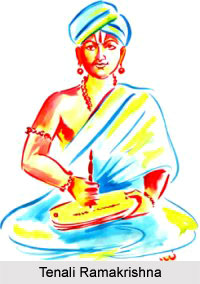 The Vijayanagar rulers were great patrons of art and literature. The `ashtadiggajas` were the eight great poets in the court of theVijayanagar king Krishnadeva Raya (1509-1529 A.D.). Some of the kings of the Vijayanagar were themselves very good poets and authors of a number of texts.
The Vijayanagar rulers were great patrons of art and literature. The `ashtadiggajas` were the eight great poets in the court of theVijayanagar king Krishnadeva Raya (1509-1529 A.D.). Some of the kings of the Vijayanagar were themselves very good poets and authors of a number of texts.
Krishnadeva Raya was one of those all round rulers of Vijaynagar, who offered patronage to many poets and artists. This emperor was a scholar and poet and his poem `Amuktamalyada` was one of the five `wabakavyasor` great poems in Telugu literature. There were lots of scholars and poets in his court in present day Karnataka, who flourished under his patronage. As per the prevailing tradition at that time, there were eight important poets in his court known as the `diggajas` in Hindu tradition. The term `diggaja` is referred to the elephants that bear the earth and the eight poets at Vijayanagara were called `ashtadiggajas`.
These `ashtadiggajas` included the names of the poets Allasani Peddana, Nandi Timmanna, Ayyala Raju Ramabhadriah, Dhurjati, Madayagari Mallanna, Tenali Ramakrishna, Pingali Suranna and Ramaraja Bhushana. According to some scholars, there is a doubt about the presence of the last two poets during that period. But it was a general and well accepted faith that all of them enjoyed the patronage of this scholar king.
Allasani Peddana was the most important among the`ashtadiggajas` and his chief work was `Swarochisha Manucharita`, which deals with an episode from the Markandeya Purana. The emperor Krishnadeva Raya is said to have great admiration and respect for this poet and whenever the king saw him, he used to take him around on his elephant. He was also rewarded with several gifts and donations of land by the king.
Another poet of the `ashtadiggajas` named Nandi Timma composed the well known work `Parijatapaharanamu` in Telugu. This composition deals with the theme of Krishna getting the divine parijata flower from Lord Indra`s garden for his wife Satyabhama. The poet dedicated this work to Krishnadeva Raya.
Dhurjati is another great poet of the `ashtadiggajas`. He composed the `Kalabasti Mahatmyam` and the `Kalahastislarara Shatakam` in praise of Lord Siva of Kalahasti (Andhra Pradesh) as he was a great devotee of this deity.
Pingali Suranna and Ramaraja Bhushana (ornament of Ramaraja`s court) are said to be two other diggajas of the `ashtadiggajas`. The most famous composition of Pingalli Suranna`s was the `Raghavapatidariyafatt`. This work is considered to be one of the five mahakavyas of Telugu literature. He had lived for a very long time till the end of the 16th century A.D. He also got the patronage of the chief of Nandyala known as Krishna Raja.
Tenali Ramakrishna was more known as Tenali Rama. This diggaja is still remembered for his humour and wit and was a very talented and popular poet cum scholar. Udbhata-radhya Charitran was one of his first poems. He was dedicated to the governor of Kondavidu during Krishnadeva Raya`s time. `Panduranga Matatmyamu` was a poem written by him and it was regarded as one of the great literary beauty.
The last among the `ashtadiggajas` was Ayyalaraju Ramabhadriah, who composed the `Ramabhudavaw`, `Ramaraja Bhushana` and the `Vasucharitramu`.



















